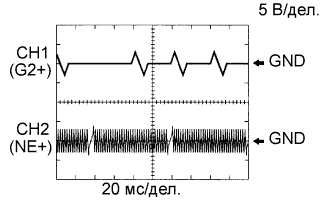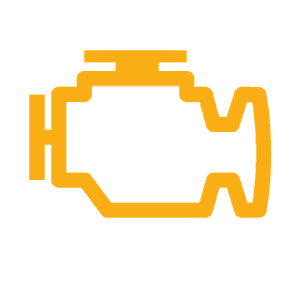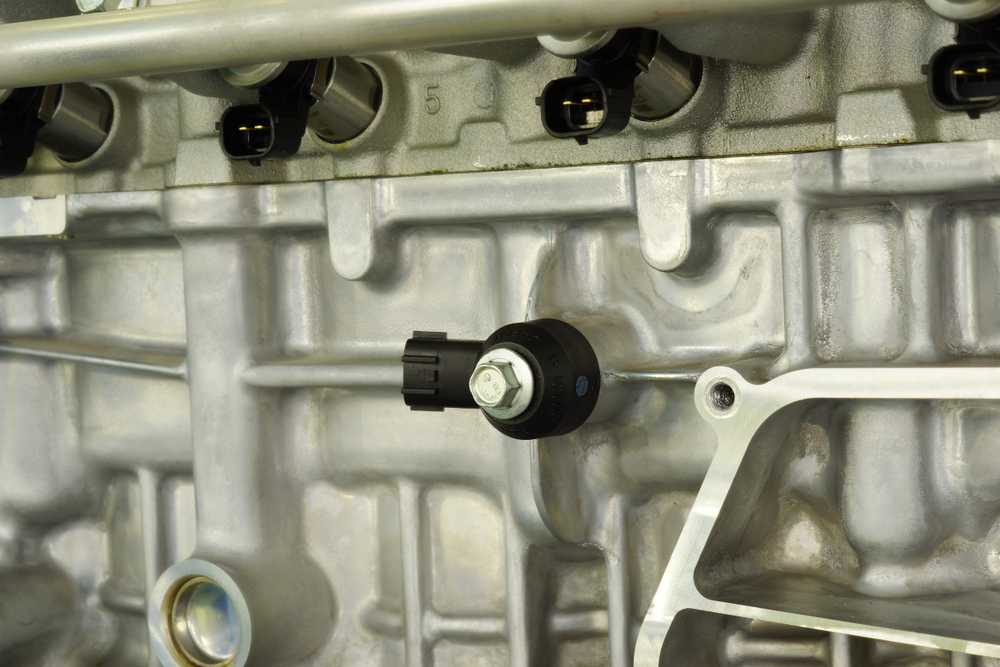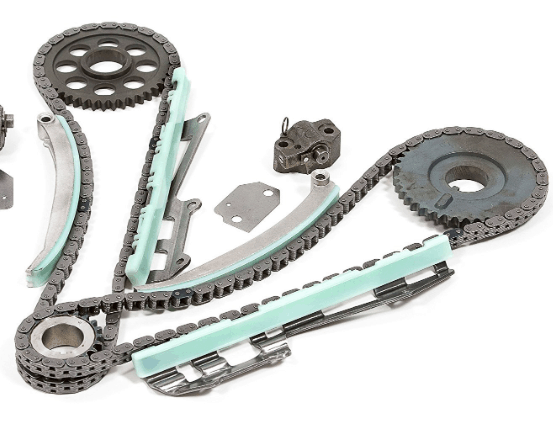ОПИСАНИЕ
Датчик положения распределительного вала (CMP) состоит из магнита и стального стержня, обернутого медной проволокой, и устанавливается на головке блока цилиндров. При вращении распределительного вала каждый из его 3 зубьев проходит через датчик CMP. Это активирует магнит внутри датчика, что генерирует напряжение в медной проволоке. Вращение распределительного вала синхронизировано с вращением коленчатого вала. Если коленчатый вал прокручивается дважды, напряжение в датчике СМР генерируется 3 раза. Генерируемое в датчике напряжение выступает в качестве сигнала, позволяя блоку ECM определить положение распределительного вала. Данный сигнал используется для управления углом опережения зажигания, продолжительностью впрыска топлива и системой VVT.
| № DTC | Условие обнаружения DTC | Неисправный участок |
| P0340 | Случай 1
Случай 2
|
|
Код DTC P0340 указывает неисправность, связанную с (+) цепью датчика СМР (жгут проводов между ECM и датчиком CMP, а также самого датчика CMP).
Для справки: Проверка с помощью осциллографа.

- Форма сигнала должна соответствовать показанной на рисунке.
- G2+ относится к сигналу датчика СМР, а NE+ – к сигналу датчика положения коленчатого вала (CKP).
- Неисправное заземление экрана кабеля может привести к возникновению помех на осциллограмме.
| Параметр / Устройство | |
| Контакты | CH1: G2+ — G2- CH2: NE+ — NE- |
| Настройки оборудования | 5 В/дел. 20 мс/дел. |
| Режим | Прокручивание коленчатого вала стартером или работа двигателя на холостом ходу |
Symptoms of P0340
When you experience a P0340 code in your Toyota Camry, there are several symptoms that you might notice. These symptoms can indicate that the Camshaft Position Sensor (CPS) is not functioning properly and can cause various drivability problems, including:
- Check Engine Light
- Lack or loss of power
- Engine stalling
- Increased fuel consumption
- Poor idle quality
- Misfiring

One of the most common symptoms you will encounter is the Check Engine Light illuminating on your dashboard (which is why you’re here, so let’s move on).
In addition to the Check Engine Light, you may experience a lack or loss of power when you drive your Camry.
This symptom is often accompanied by poor idle quality, misfiring, and increased fuel consumption. The P0340 code can also affect the fuel injection and ignition systems, leading to other related issues.
Another noticeable symptom is engine stalling. A faulty CPS can cause your engine to stall unexpectedly, making it difficult to start or resulting in a completely non-functional ignition system. As the computer signal weakens, your vehicle’s camshaft position sensor may prevent your ignition from sparking at all, leading to total ignition failure.
Diagnosing and Fixing P0340

Diagnostic Tools
To diagnose and fix the P0340 code in your Toyota Camry, you will need a few professional diagnostic tools. These tools include an oscilloscope, a multimeter, and an OBD-II scanner. Consult your vehicle’s service manual for specific instructions on how to use these tools properly.
Checking Wiring and Sensor
First, check the wiring and connectors for any signs of wear or damage. If you find any issues, repair or replace them as needed. Next, use your multimeter to check the voltage at the camshaft sensor to ensure it is within spec.
If the wiring and voltage at your Camry’s camshaft sensor are where they should be you might need to inspect the camshaft position sensor and the crankshaft position sensor. Use the oscilloscope to compare the signals from both sensors. ]If there is a significant difference between their readings, consider replacing one or both sensors.
Resetting the Code and Re-evaluation
Once you’ve completed the necessary repairs or replacements, use your OBD-II scanner to reset the diagnostic trouble code (DTC). Make sure to follow the manufacturer’s recommended procedure for clearing codes.
After resetting the code, test drive your Camry to evaluate the performance and see if the P0340 code reappears. If the code does return, it may be advisable to consult with a mechanic for further diagnosis and expert assistance.
Remember to be professional in your approach and carefully follow the required steps to address the P0340 code in your Toyota Camry.
What are the common causes of code P0340?
The most common causes of code P0340 on Toyota vehicles are largely similar across all Toyota applications, and could include one or more of the following, but note that possible causes are listed here in their order of prevalence, with the most prevalent causes listed first-
- Burnt, damaged, shorted, disconnected, or corroded wiring in the sensors’ reference and/or signal circuits
- Failed or failing camshaft position sensor, or the use of an unsuitable aftermarket sensor
- Failures, defects, or malfunctions in the variable valve or camshaft systems that prevent the camshaft from returning to its base position after engine shutdown. Note that this is more likely to be caused by low oil pressure and/or old, dirty, or degraded engine oil causing variable valve timing components to bind or stick than by actual failures of variable valve timing system components
- Damaged or worn valve timing components such as worn timing belts/chains, worn or damaged timing chain guides, or worn timing sprockets
- Failed or failing crankshaft position sensor, but note that this will usually be indicated by one or more dedicated crankshaft position sensor trouble codes
- Failed or failing PCM, but note that since this a rare event, the fault must be sought elsewhere before any control module is reprogrammed or replaced
What are the symptoms of code P0340?
Common symptoms of code P0340 on Toyota vehicles are largely similar across all Toyota vehicles and could include one or more of the following. Note, however, that depending on the vehicle and the nature of the problem, the severity of one or more symptoms listed here can vary substantially between applications-
- Stored trouble code and illuminated warning light
- Depending on the nature of the problem, multiple additional codes may be present along with P0340
- The engine may start, but shuts off again almost immediately
- The engine may only start after extended periods of cranking
- If the engine starts and runs, the idling quality may be poor, and persistent misfires may be present
- Varying degrees of power loss may be present- if the engine starts and runs at all
- The engine may stall repeatedly and/or unexpectedly at low engine speeds
- Fuel consumption may increase noticeably
Definition of P0340
Camshaft Position Sensor – “A” Circuit
P0340 is an OBD-II diagnostic trouble code (DTC) that indicates that the powertrain control module (PCM) has detected a problem within your Camry’s CPS circuit, which can negatively impact your vehicle’s performance and fuel efficiency.
This error can arise from a failure, defect, or malfunction in the control, signal, or reference voltage circuit(s) of the position sensor connected to the intake camshaft. It is crucial to address this issue promptly since it can potentially lead to further complications in your vehicle.
The causes of P0340 in the Toyota Camry can vary and go beyond the camshaft position sensor itself. Some possible causes include:
- A faulty camshaft position sensor
- Damaged or corroded wiring and connectors
- Timing chain or belt issues
- Mechanical problems with the camshaft or crankshaft
- Problems with the powertrain control module (PCM)
Causes of P0340 in the Toyota Camry
Defective Camshaft Position Sensor

One common cause of the P0340 code in your Toyota Camry is a defective camshaft position sensor. This sensor plays a crucial role in managing the engine’s ignition spark and fuel injection timing.
If it fails or malfunctions, it can lead to rough idling, misfires, loss of power, and increased fuel consumption. It’s important to check the sensor itself for any signs of damage or wear, and replace it if needed
Corroded Wiring Harness
Another potential cause of the P0340 code is corroded or damaged wiring connecting the camshaft position sensor to the engine control module (ECM).
The wiring in your Camry may be exposed to harsh conditions, resulting in corroded or damaged connections that affect the sensor’s performance.
You should carefully inspect the wiring for any visible signs of corrosion or damage, and, if necessary, repair or replace affected wires to ensure proper signal transmission between the sensor and ECM.
Faulty Timing Chain

A faulty timing chain can also contribute to the P0340 code in your Toyota Camry. The camshaft position sensor relies on accurate timing information to function properly, and a worn or damaged timing chain can disrupt this process.
If you suspect that the timing chain may be at fault, it’s essential to have it inspected and replaced, if needed, to prevent further engine issues and potential damage to other components.
Как устранять ошибку P0340?
Поскольку P0340 и P0345 относятся к проблеме цепи, не вините сразу же датчик положения распредвала. Это не означает, что проблема не в датчике, но его замена датчика не всегда решит проблему. Возьмите схему подключения и цифровой мультиметр.
- Визуальный осмотр. Убедитесь, что датчик подключен и надежно установлен. Кроме того, следуйте по жгуту проводов, чтобы проверить наличие повреждений, например, в результате недавнего ремонта двигателя, монтажа оборудования, повреждений при ударе и т. п.
- Осмотр датчика. Проверка сопротивления. Отсоедините датчик и измерьте сопротивление.
Разомкнутая цепь (∞ Ω — бесконечное сопротивление) или короткое замыкание (0 Ω — сопротивление 0 Ом) говорит о том, что сам датчик неисправен.
Проверка сигнала. Правильный способ сделать это — использовать цифровой осциллограф, но вы можете получить приблизительную оценку работоспособности ДПРВ, переведя мультиметр в режим AC V (переменное напряжение). При проворачивании двигателя вы должны видеть не менее 20 мВ. Осмотр электрооборудования. Отсоедините разъёмы контроллера и ДПРВ. Подключите перемычку к разъёму датчика. Для этого вы можете использовать небольшую скрепку или кусочек провода.
Проверьте сопротивление цепи со стороны блока управления. С перемычкой сопротивление должно быть менее 0,1 Ом. Чем выше, тем хуже. Ищите где-нибудь в цепи обрыв провода или коррозию.Уберите перемычку и проверьте сопротивление цепи — оно должно быть бесконечно (∞ Ω). Если есть некоторое сопротивление, возможно короткое замыкание. Вода в промежуточных соединениях легко может стать причиной этого.
Проверьте на предмет замыкания на массу, измеряя сопротивление между каждым проводом и землей или отрицательной клеммой аккумулятора. Вы должны получить бесконечное сопротивление. Любое непреднамеренное соединение с землей может исказить или ослабить сигнал.
Другие проблемы. Если в ДПРВ или его проводке проблем не обнаружено, возможно, P0340 или P0345 являются просто сопутствующими кодами неисправностей. Перескочил ремень ГРМ, неисправный сигнал или цепь датчика положения коленчатого вала или пропуски зажигания двигателя могут быть основной проблемой. Дважды проверьте их, прежде чем вернуться к ДПРВ.
Frequently Asked Questions
How much does it cost to fix a P0340 code?
The cost to fix a P0340 code in your Toyota Camry can vary depending on the specific issue. If the problem is a faulty camshaft position sensor, the cost of the replacement may range from $100 to $200, for the parts. Labor can get a lot higher depending on how hard the CPS is to get to.
If the issue is related to wiring or a faulty engine control module (ECM), the cost could be higher.
Is it safe to drive with a P0340 code?
While your Camry may still run with a P0340 code, driving with this issue could result in reduced engine performance, poor fuel efficiency, and the risk of further engine damage.
It is recommended to address the issue as soon as possible to maintain the safety and reliability of your vehicle. Continuing to drive with a P0340 code may lead to more expensive repairs down the road.
How do I clear a P0340 code after repair?
After you’ve repaired the issue causing the P0340 code, you can clear the code by using an OBD-II scanner. Plug the scanner into your Camry’s OBD-II port, turn the ignition on, and follow the instructions on the scanner to erase the code.
If the repair was successful, the code should not return and the check engine light will turn off. However, if the code reappears, there may be other underlying issues that require further investigation.




























